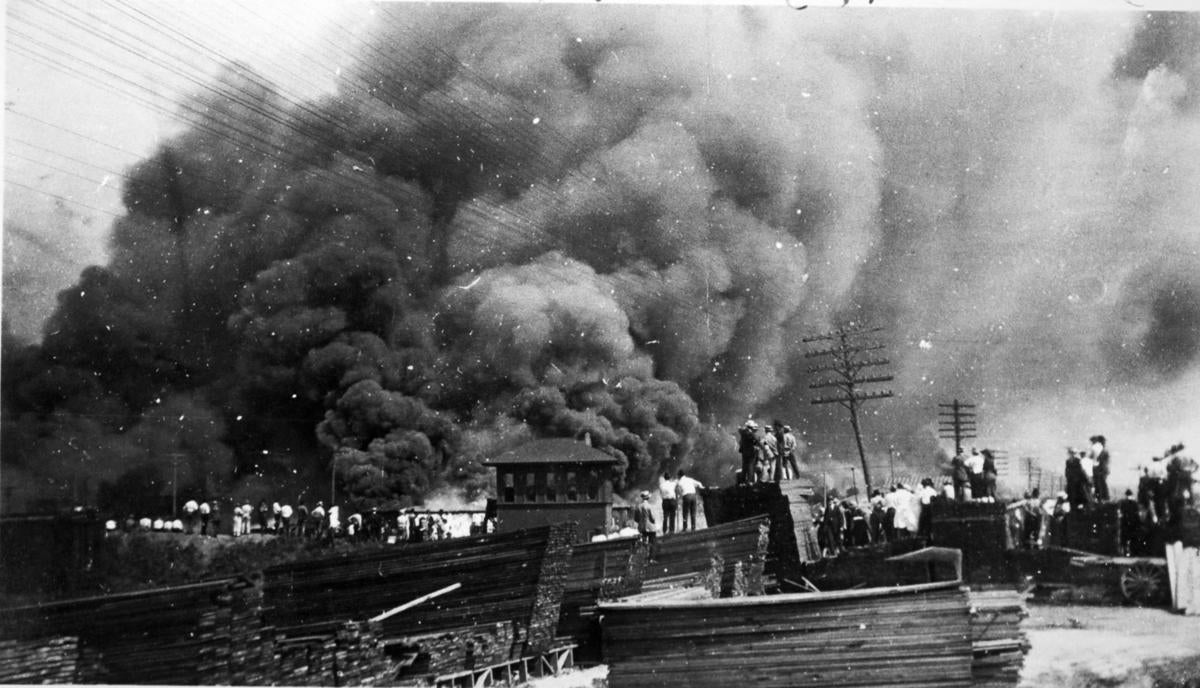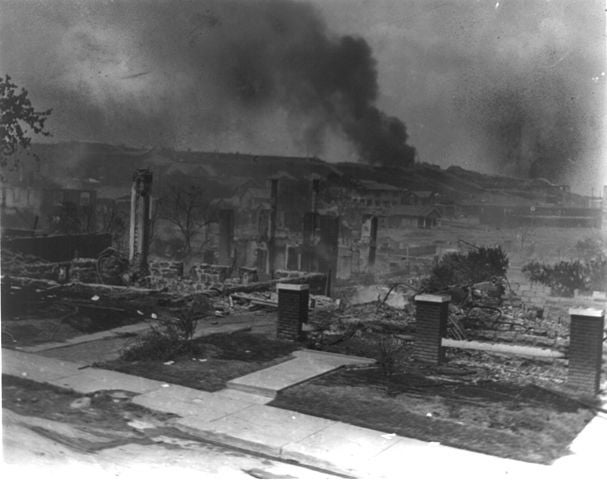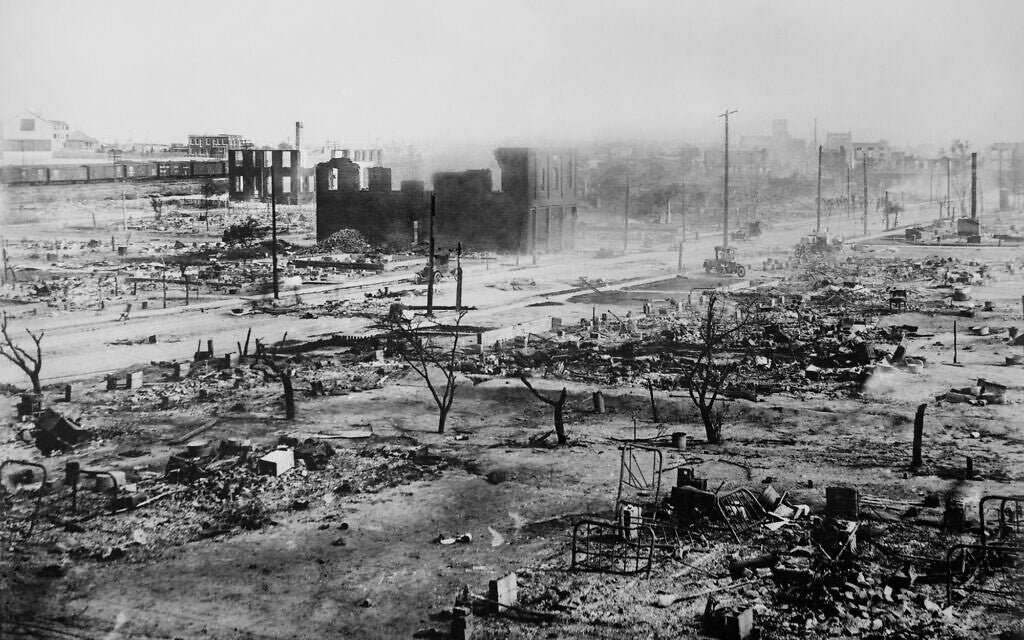This year marks the centennial of the Tulsa Race Massacre, which saw the destruction of a Black community in Oklahoma that, despite the brutality of state-sanctioned segregation, achieved an uncommonly strong level of commercial prosperity. The community was hailed as Black Wall Street because of the surplus level of businesses that thrived in this unlikely environment.
On May 19, the U.S. House of Representatives Judiciary Subcommittee on the Constitution, Civil Rights, and Civil Liberties coordinated a hearing titled “Continuing Injustice: The Centennial of the Tulsa-Greenwood Race Massacre.” Three witnesses who lived through the Massacre testified before the subcommittee on their experiences during and after the tragedy, and their disappointment that justice still remained elusive 100 years later.
The Incident: At 4 p.m. on May 30, 1921, 19-year-old Dick Rowland left his job at a shoeshine stand on Tulsa’s Main Street to go to the bathroom. Rowland was a Black youth in a city where the laws ensured minimal interaction between the races. Blacks could not use public restrooms in that part of the city, but the management of the Drexel Building, where his shoeshine stand was located at street level, set aside a “colored bathroom” on the building’s third floor.
Rowland walked into the building, which was mostly empty because it was Memorial Day and many of the offices therein were closed. Sarah Page, a 17-year-old white girl, had to work that day — she was an elevator operator and took Rowland on his trip to the third floor.
The elevator ride up was uneventful, but on the ride down something happened that remains a mystery to this day. Page screamed as the elevator door opened and Rowland ran out into the street.
When police arrived, Page said that Rowland grabbed her arm, which caused her to scream — yet she never explained why Rowland, a decent and well-mannered youth, would suddenly behave so gravely out of character. She declined to file criminal charges against him.
Police located Rowland the next day and took him to the Tulsa courthouse, located not far from the Drexel Building. That afternoon, the Tulsa Tribune published a front-page article with the headline “Nab Negro for Attacking Girl in an Elevator” and falsely reported Rowland scratched Page’s face and tore her clothing.
In the same edition, Rowland was the subject of another article with the headline “To Lynch Negro Tonight,” which many people in Tulsa saw as a cue for vigilante action.
Around 7:30 p.m., a mob of several hundred white residents congregated in front of the Tulsa County Courthouse. A three-man delegation entered the courthouse and demanded the sheriff hand Rowland over to them. The sheriff refused.
Two hours later, a group of between 50 and 60 Black men appeared at the courthouse. Many of them were World War I veterans who fought for liberty overseas but had been denied basic civil rights in their own country. They had become frustrated at being treated as second-class citizens and were disgusted that yet another Black man faced lynching by a white mob. The men openly carried guns and informed the sheriff at the courthouse that they would help to defend Rowland against the mob.
News of the standoff quickly spread throughout the city, and both sides saw their numbers reinforced with gun-toting white and Black residents. At 10 p.m., a white man attempted to disarm a Black man. A shot was fired — by whom is unknown — and chaos erupted.

Viola Fletcher’s Testimony: Viola Fletcher was introduced to the congressional subcommittee as the oldest living survivor of the Massacre. Although her slight demeanor within a wheelchair gave the impression of physical frailty, Fletcher spoke with a clarity that demanded attention.
“I am 107 years old and have never seen justice,” she said. “I pray that one day I will. I have been blessed with a long life — and have seen the best and worst of this country. I think about the horrors inflicted upon Black people in this country every day.”
Fletcher detailed what she experienced as a child: Black men being shot down in the street, Black-owned businesses being torched, a once-placid neighborhood engulfed in smoke, flames and screams.
She recalled how her family was forced to leave Tulsa and how the remainder of her life was marred with lost opportunities and poverty while the Tulsa city government enriched itself through $30 million raised by the Tulsa Centennial Commission.
“I am asking that my country acknowledge what has happened to me,” she said in a voice that resonated with strength. “The trauma. The pain. The loss. And I ask that survivors and descendants be given a chance to seek justice.
“I live through the Massacre every day,” she added. “Our country may forget this history. I cannot. I will not. The other survivors do not. And our descendants do not.”
The Beginning of the Carnage: In the late 19th and early 20th centuries, Oklahoma’s oil and mining industries created a surplus of well-paying jobs, and many Blacks from the Deep South relocated to the state in search of better opportunities. This sudden rush of prosperity elevated many Blacks to middle-class status.
Tulsa’s Black community created a vibrant, thriving business oasis covering 35 city blocks in the Greenwood section of the city. Black doctors, lawyers, merchants, grocers and real estate brokers catered to residents who were not welcomed in the businesses and practices run by their white counterparts.
Greenwood also included eight churches, two hospitals, two Masonic lodges, four hotels, two movie theaters, schools, a funeral home, auto garages and a local newspaper. The homes in the neighborhood were among the finest in the city. The commercial innovation and prosperity of the area were so great that civil rights leader and educator Booker T. Washington praised it as Black Wall Street.
As the late hours of May 31 rolled into June 1, white mobs forgot about lynching Dick Rowland and took their anger out on the wider Black community that dared to stand up for justice.
Tulsa was an overwhelmingly white city. Black citizens made up one-tenth of the 100,000 population, and the Black residents who sought to defend Rowland were no match against the vast numbers that turned against them.
Homes in Greenwood were set ablaze in the middle of the night, with frightened residents running out into the streets with only the clothing they wore. Many were shot as they sought to flee from the fires, and white vandals jumped over the bodies of slain Black men and women to loot their homes.
The Black-owned businesses of Greenwood were also the target of arson attacks. The flames were too overwhelming for the local fire departments to address with some reports stating the white mobs threatened firefighters at gunpoint if they tried to douse the flames.
Many Black residents who possessed weapons fired back at their assailants. Throughout the night, gunfire was exchanged from automobiles, alleys and rooftops. When morning came, airplanes flown by white pilots circled Black Wall Street and began to drop turpentine bombs on Greenwood, and the buildings of Black Wall Street cratered and collapsed into ruin from the aerial assault.

Hughes Van Ellis’ Testimony: The congressional subcommittee also heard from Fletcher’s brother, the 100-year-old Hughes Van Ellis, who was an infant when the Massacre occurred but who nonetheless lived with his family’s trauma of losing everything and never being able to recover financially or emotionally.
“The Tulsa Race Massacre isn’t a footnote in a history book for us,” he said, speaking slowly but firmly. “We live with it every day and the thought of what Greenwood was and what it could have been.
“We aren’t just black and white pictures on a screen,” he continued. “We are flesh and blood. I was there when it happened; I’m still here. My sister was there when it happened; she’s still here.”
The hatred his family experienced in Tulsa continued throughout his adult life, Van Ellis said. He mentioned his World War II service and the indignities he faced within the segregated military and the segregated society that greeted him when the conflict was over. But he also stressed that he believed in his country and its ideals.
“We’re not asking for a handout,” he told the legislators. “All we are asking for is for a chance to be treated like a first-class citizen who truly is a beneficiary of the promise that this is a land where there is ‘liberty and justice for all.’”
Amid The Wreckage: Shortly before noon on June 1, martial law was declared in Tulsa. National Guard troops rounded up Tulsa’s Black residents. Up to 6,000 were placed in makeshift detention centers around the city; many were held for up to a week, allegedly for their own protection.
No accurate tally of casualties was ever determined. Eyewitnesses would later recall seeing stacks of bodies piled up. Mass graves were hurriedly dug to bury the dead — no coffins were used to dispose of the dead. The Red Cross estimated there were at least 300 fatalities, but many historians believe that number is too conservative.
Black Wall Street was completely obliterated, with nearly 200 commercial properties across Greenwood left in rubble. More than 12,000 people were left homeless and more than 1,400 homes were either burned or looted.
Lessie E. Benningfield Randle’s Testimony: A third survivor of the Massacre, 106-year-old Lessie E. Benningfield Randle, offered her testimony in a virtual presentation.
“I remember running outside of our house,” she said. “I ran past dead bodies. It wasn’t a pretty sight. I still see it today in my mind, 100 years later.
“I was so scared,” she continued. “I didn’t think we would make it out alive.”
Randle faulted the Tulsa city government and the Oklahoma state government for failing to compensate the survivors.
“I am here today, at 106-years-old, looking at you all in the eye,” she said. “We've waited too long, and I am tired. We are tired. I am asking you today to give us some peace. Please give me, my family, and my community some justice.”
An Attempted Erasure: In the aftermath of the Massacre, Tulsa’s city government passed ordinances to make rebuilding in Greenwood difficult. Nonetheless, many residents returned and began to piece together the ruined community. While the Red Cross and philanthropic outreach helped these residents, their attempts to gain financial compensation from the city government and their insurance policies were unsuccessful.
No person was ever charged with the crimes inflicted on the people of Greenwood. John A. Gustafson, Tulsa’s chief of police, was brought to trial and convicted of dereliction of duty and aiding auto thieves.
The Massacre was widely covered by the nation’s newspapers in 1921, but in subsequent years there seemed to be an enforced amnesia to remove the event from history.
City and state archives were also wiped of records relating to the event. The Tulsa Tribune article that planted the seed of lynching Dick Rowland was removed from the newspaper’s archives.
Rowland also disappeared. He was released from police custody after the Massacre, but to date, historians have been unable to determine what became of him.
For many years, mention of the Massacre was omitted from history books released by Oklahoma’s state government. Schools across the U.S. failed to include the event in their history curriculum, and for decades most Americans were unaware of what occurred.
In the 1970s, the rising interest in Black studies resulted in the story of the Massacre being pieced together. Photographs and first-person narratives that were never publicly seen slowly emerged. A new wave of scholarship emerged to excavate the story of the Massacre from obscurity and place it within the wider context of the nation’s troubled racial history.
By 1996, Oklahoma’s state legislature authorized the creation of a commission to investigate what was dubbed the “Tulsa Race Riot” to determine restitution. Five years later, the commission issued a report calling for reparations to descendants of the Massacre’s survivors, along with historic preservation efforts to recall Greenwood’s halcyon days and scholarships for the survivors’ descendants.
While time may never not fully heal the wounds inflicted on Black Wall Street and the residents of Greenwood, the centennial observance of the Massacre will ensure the story is not forgotten.
“By the grace of God, I am still here,” said Randle in her testimony. “I have survived. I have survived to tell this story. I believe that I am still here to share it with you. Hopefully, now, you all will listen to us while we are still here.”

(Photographs courtesy of the Library of Congress.)
© 2025 Benzinga.com. Benzinga does not provide investment advice. All rights reserved.
Trade confidently with insights and alerts from analyst ratings, free reports and breaking news that affects the stocks you care about.